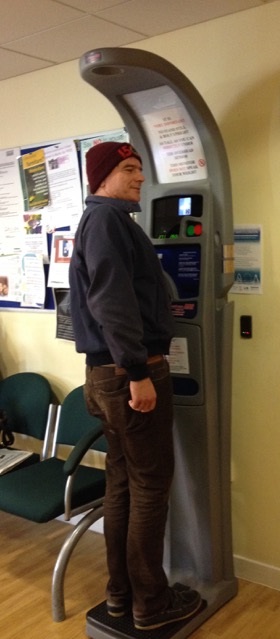
16th March 2015

Physical health monitoring pods in use in City and Hackney
In March the QI team caught up with Dr Caroline Methuen, Consultant in Primary Care Liaison, Psychiatric Outpatients Department in City & Hackney about the QI project she is leading on improving access to physical health monitoring for ELFT patients
Please tell us who is in your team and how you are planning to increase physical health monitoring for patients on antipsychotic medication?
Our core QI team includes doctors, admin and reception staff, nurses and a pharmacist but the project has an impact and needs support from the wider community mental health teams across Hackney and the City.
We are trying to think of new and innovative ways in which we can measure our patients’ physical health at our community team bases. We have traditionally asked our patients to always go to their GP for physical health monitoring, but we feel we need to take more responsibility in looking after our patients’ physical health within our services and building close links with primary care so that we are working together to help our patients. We recognise that when patients attend our services it is an opportunity to capture important measurements about their physical health and well being. We want to concern ourselves with the whole clinical picture, both mental and physical health, when people visit us.
Our latest idea involves using a “pod”, which is an interactive machine which patients can use why they are in the waiting rooms of our community bases. It measures weight and height, calculates Body Mass Index (BMI) takes blood pressure and measures pulse. The advantage of this machine is that the results are printed onto a ticket which can be brought into the appointment, gets reviewed by the clinician and entered into patient’s record by the healthcare professional.
Why is physical health so important to a group of clinicians in a mental health trust?
We believe that you cannot separate mental and physical health into separate categories, one affects the other and we should be thinking about our patients more holistically, as a whole person, rather than only dealing with their mental health and leaving their physical health for other professionals to look after.
It is well-established that people with mental health problems are at an increased risk of adverse physical health outcomes. Among patients with a severe and enduring mental illness such as schizophrenia, an estimated 60 per cent of excess mortality is due to physical illness. A person with a severe mental illness is more likely to have a co-morbid physical health problem, and is more likely to die of that illness within five years, when compared to the general population. So having a mental illness is just as bad for your physical wellbeing as it is for your mental wellbeing.
Thinking about it the other way round it is also the case that having physical illnesses can be bad for your mental health. Having a long term physical condition can have a detrimental impact on a patient’s mental health, especially mood problems. Physical illnesses including cardiovascular disease, cancer, epilepsy and stroke can lead to depression. Rates of mental health problems have been found to rise as the number of long-term physical conditions increases and as socio-economic deprivation worsens. Coexisting mental and physical illness is often intertwined with social exclusion and deprivation.
The statistics are stark, yet physical health problems continue to be under-addressed among people with mental health problems, while the mental health of people with long-term physical conditions is all too often neglected. The persistent excess morbidity and mortality in people with mental health problems, and in people with an intellectual disability, underlines the urgent need to redress the situation and make ‘parity of outcomes’ across physical health, mental health, and intellectual disability a reality.
How have you engaged patients in your project to date?
We have are actively getting feedback from our service users and carers who have used the machines. The initial results look promising, patients seem to like using the pod and they are finding it easy to use. We are hoping to use our local patient participation lead to identify service users or carers who would be interested in working with us on the project, we feel confident that this is a topic that is important to patients and their carers.
Finally, what advice would you give to groups thinking about tackling the same problem?
My advice would be to ensure that you have the right people in your team at the beginning planning stage of the project. When we first formed the team we were mainly doctors, but we realised early on that we needed to involve other members of the healthcare team such as the physical health lead nurse (Carol Shannon) to help us. We also saw that it was vital to include and engage reception staff in our project, as the pods are in reception areas and the reception staff will be key people in prompting patients to use the machines. I would also say that it is also important to make sure that systems are in place and involve the management team to support your project, for example in our project it was vital to ensure that there were service level agreements for blood tests and ECGs at Homerton hospital, so that we could get these investigations for our patients without having to ask their GPs to order them. Finally it is important to have a project that you feel passionate about, that is what will drive things forward.
Thank you to Caroline and the team in City and Hackney for sharing their progress with this QI project so far
18th July 2018

20th May 2019

22nd March 2016
21st January 2021

31st March 2023

18th March 2019


To keep up to date on the latest concerning QI at ELFT, follow us on our socials.


